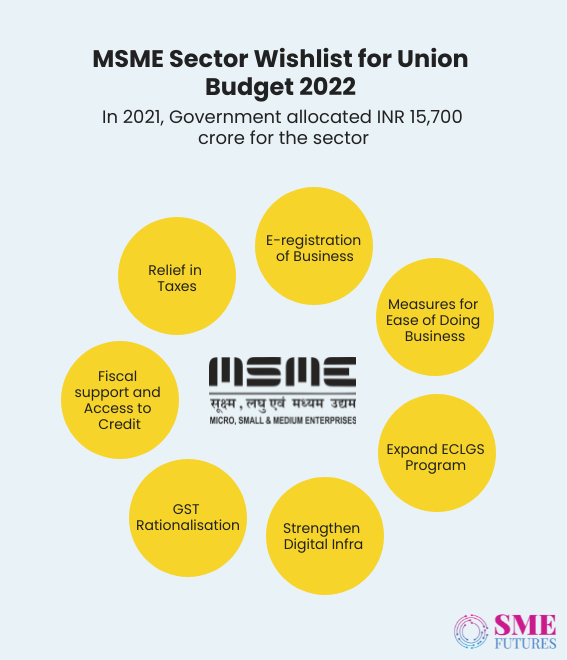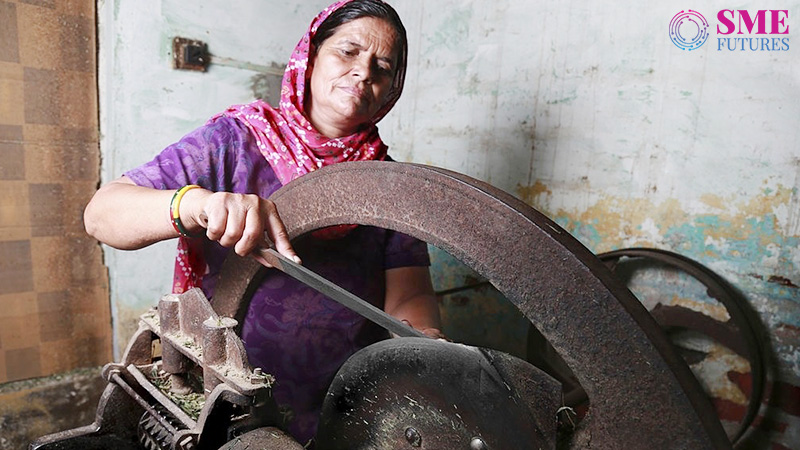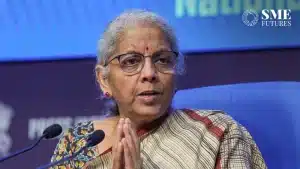Last year, in the budget for 2021-22, a number of steps were taken to support the MSME sector, and the government allocated Rs 15,700 crores to this sector. This year, given the staggering effects of COVID-19 on the economy, there’s a lot riding on the Union Budget 2022. As many are expecting it to revive the MSME sector from the severe slowdown caused by the second and the third waves of the pandemic.
The focal point of this budget should be about devising a robust growth map to revive the economy. As the MSMEs contribute around 30 per cent to India’s GDP, they are a key employment generator in the country.
This Union Budget 2022-23 is highly crucial for aligning the Indian economy’s growth trajectory. And India Inc. is hoping for various incentives and measures from it for making their businesses sustainable. There are several key focus areas which FM Sitharaman must address in order to achieve this.
Fiscal support and access to credit
The MSMEs biggest obstacle is their lack of access to finance.
In the backdrop of an uneven recovery, there is near saturation of consumption demand from a section of the population while a large majority witnesses a contraction or weakening in consumption demand due to income losses and higher inflation.
With the MSME sector being heavily strapped for capital, there has been an uptick in the overall demand for credit.
Jay Shankar, Head of Economics Research, InCred Equities strongly feels that fiscal support will be critical in deciding India’s growth trajectory, saying, “Private consumption and private investments are likely to be on a modest recovery path and net exports are also increasingly losing steam.”
According to him, it would be imperative for the budget to focus more on the demand side. Accordingly, fiscal support to the smaller and micro firms in the broader MSMEs, especially those in the informal sector that create more jobs, should be prioritised.
Nitin Sharma, CPTO & MD – SME Business at UpScale and CredAble says that the government needs to introduce specific schemes to infuse more liquidity into the system and further ease the disbursement of funds to the MSMEs.
“Like last year’s double budgetary allocation, this year too — provide adequate financial support to MSMEs. In addition, the government should look at increasing the banks’ PSL lending quota to MSMEs which currently is under 10 per cent,” he informs us.
Debt, on the other hand, is a critical issue for MSME owners, stressing them financially. Aparna Dubey, founder of Changing Orbits, a mid-market advisory firm, suggests that the problem can be mitigated with a restructuring scheme.
“As per the Reserve Bank of India, 80 per cent of SME debt is in the ‘high risk’ category. A ‘fast-track’ scheme to enable SMEs’ to restructure their debt will augur and augment their financial performance,” she says.
Support to NBFCs
In the past few years, operationally nimble and technologically oriented NBFCs and fintechs have deepened the credit penetration to the underserved regions of the country. Hence, in the upcoming budget, policymakers should give due consideration to boost liquidity support to the NBFCs as well as encourage frameworks like co-lending, which will greatly boost the reach of financial institutions as progress on the financial inclusion front is imperative.
Commenting on the same, Shacindra Nath, Executive Chairman and MD of U GRO Capital says, “EASE 4.0 talks about co-lending between banks and NBFCs as a means to increase credit penetration. However, the treatment of Tax Deduction at Source (TDS) for NBFCs and Banks is different and that is proving to be a major operational challenge towards accelerating credit. It is expected that TDS rules would be harmonised between the banks and the NBFCs.”
The other key angle that needs to be looked at is the last mile coverage for lending.
To cover the geographical depth, banks should lend to the smaller NBFCs depending on their past performance, suggests Sharma. “These NBFCs have better reach when it comes to small businesses and empowering them will ensure the broadening of the overall credit coverage for the MSMEs,” he says.
Whereas, Ankit Mehra, Founder and CEO, GyanDhan adds that MSMEs need a few relaxations in co-lending norms as well. “Particularly, enabling public sector banks to enter into more co-lending arrangements with smaller NBFCs should be done to serve the gaps in financing for the MSME sector,” he comments.
Vikesh Agrawal, CEO at Ajva Fintech opines that given the current business environment, even MSME lenders have raised debt at significantly higher rates than banks because of their limited vintage or the perceived risk in the MSME segment as an asset class. There is clearly a need for creating an enabling eco-system for the MSME lenders to raise debt and raise it at a cheaper cost.
Bringing back the 2 per cent interest subvention scheme and the Technology Upgradation scheme for micro enterprises will be helpful. Linkage of GST data with the TReDS platforms is another recommendation. Invoices issued by an MSME where credit has already been availed by the buyer should be auto available for discounting.
Another suggestion is to incentivise the buyers (especially large, category A corporates) of the MSMEs to come and enrol themselves on bill discounting platforms and accept the invoices raised by these MSMEs. Also, incentivising even small players to adopt GST by reducing compliances to the very small institutions should be done. This will facilitate financing using GST data. These are a few measures that should be taken for credit availability.

Expand the ECLGS Program
Sanjay Sharma, MD at Aye Finance emphasises on the expansion of the ECLGS program. According to him, it is important that the rates of interest in these schemes should not be capped.
“It will encourage lenders to make these funds flow to the micro scale businesses where the operating costs are high. Capping the rate of interest diverts most of these funds to the bigger enterprises and thus starves the neediest micro businesses,” he says.
The loan restructure program has been the life support for so many micro businesses that have been established after years of toil by their owners. “We are not yet out of the woods and the lenders should hence be allowed to extend the restructuring window by 6-12 more months, to enable these businesses to pull through this trough,” adds Sharma.
Ease of doing business
In addition to liquidity and credit, ease of doing business is next on their wish list.
Delays in the availability of finance and credit, timely payment and adjudication of pending dues, cumbersome procedural requirements, and rigid regulatory compliance have become increasingly sensitive issues for MSMEs.
Relief in taxation, a single window system, the proper implementation of the Vivaad Se Vishwas Scheme, and other relaxations can foster the ease of doing business. Here, the stakeholders are suggesting a few measures.
The Federation of Indian MSMEs in a pre-budget memorandum mentioned that for those units that were impacted due to the pandemic, a guarantee cover of 100 per cent of additional security is needed for restructuring and should be extended through the existing CGTMSE (Credit Guarantee Fund Trust for Micro and Small Enterprises) scheme or through a new instrument under the NCGTC.
Agrawal suggests a relaxation in stamp duty. “In case of an MSME trying to go to other lenders to reduce the cost of borrowing, they need to pay very high foreclosure/prepayment charges. In some cases, this ranges up to 5-8 per cent of foreclosure amount. Also, if there is mortgage as collateral, stamp duty is again required to be paid on the fresh loan. Relaxation of stamp duty on such refinance cases is required, and the relaxation can be for a fixed period. Also, norms should be set around the fixation of foreclosure charges where the refinance is on account of lower interest rates from the other lenders,” he elaborates.
As an MSME and start up founder, Ajay Lakhotia of StockGro expects a relaxation in the ESOPs taxation scheme and a reduction of the compliance burden on foreign investments.
“This will help make our businesses globally competitive and facilitate faster wealth creation across the spectrum. Moreover, Indian start-ups can unlock higher valuations if empowered to pursue foreign listings! At the consumer level, clearing the air on policies pertaining to new digital asset classes such as Crypto & NFT’s will go a long way in helping Indian investors invest stress-free. A lot more liquidity can also be unlocked among middle-class taxpayers through a reduction in the personal tax regime,” he asserts.
Dubey, on the other hand, believes that a policy focused on promoting women-owned SMEs will help close the massive gender gap that exists in India, as well as provide them with opportunities for capital, scalability, and success, resulting in ease of doing business.
Strengthen digital infra
Digital transformation has become an increasingly important factor in the success of Indian businesses over the years. And tech start-ups have played an important role in this digital journey.
While the government has been very active in pushing the digital growth of companies, considering that the MSMEs have limited sources, the stakeholders feel that more needs to be done on this front.
For instance, offline SMEs should be incentivised, suggests Dilli Babu Nandarapu, Founder & CEO at ShopConnect.
“Incentivise them to adopt and strengthen digital solutions to ensure better business prospects and for the speedy recovery of the overall economy. Moreover, digital infrastructure support will be important especially for MSME retailers since the future is getting more and more digitised, personalised, and connected,” he asserts.
In addition, accelerating the ONDC rollout will facilitate the e-commerce platform providers to offer more features and easier customer onboarding when covering the rural areas and the non-metro cities. Also, sales process outsourcing (SPO) should be promoted as it will provide more employment opportunities and at the same time global brands can leverage India’s advantage, he says.
Weighing in, Agrawal of Ajva Fintech says that the government should work on running professionally driven funds which will help in the marketing of such established brands, in addition to providing ample support to them. They can also be upscaled with partnerships or with other mechanisms like the Thrasio model.
E-registration of businesses
One long-standing demand from the government has been to start e-registration for the proprietorship and partnership firms. It would go a long way in helping business firms and will engender better credit penetration.
Talking about e-registration and why it is critical for businesses Rahul Jha, Chief Executive Officer at LEI Register India puts forth his views.
Although LEI registration has picked up pace over the past few years, it is imperative that certain measures be taken for its improved adoption on a large scale.
Hoping for some more such measures from the budget, Jha makes some recommendations, saying, “A few recommendations include allowing and making it an easy process to register businesses as a digital nomad, easing the KYC norms for corporates and business firms, and linking the Legal Entity Identifier with other registration IDs, which would be helpful for regulators and banks to understand companies better.”
However, the industry is also concerned about the KYC norms. Currently, one needs to get the open data for all business registration ids on one platform for business entities like LEI, GST, IEC, PAN, CIN, and others. If these measures are implemented effectively, it will propel the sector ahead immensely, allowing it to reach greater heights.
Rationalise GST
An easy GST framework would be a huge relief for MSMEs.
Currently the scenario is that even if the MSME businesses don’t collect from the buyer, they need to pay the government. In the absence of a proper channel for the discounting of invoices, the MSMEs end up blocking a substantial part of their working capital (5 per cent to 28 per cent of the sale value) to pay the GST on uncollected invoices.
Agrawal proposes two solutions for this, saying, “The buyer should not be allowed to take input tax credit on unpaid invoices. This way the government will collect data on unpaid MSME invoices and take appropriate action to support them. Secondly, MSMEs should pay the GST on an invoice collection basis.”
Sharma of CredAble says that this sector has its hopes pinned on the budget this year, for GST rationalisation —which if done will be a major relief, especially with the rising prices of raw materials in the manufacturing industry.
Expecting many things from the budget, Rahul Raj, Founder & CEO FloBiz also says that a reduction in GST rates and a relaxation in the compliance burden for MSMEs around taxes, audits and loans will go a long way in helping this sector regain its lost momentum.
Lastly, no budget is complete without mentioning MSMEs in it, as they will continue to be the backbone of economic growth for the country. There are hopes about taking forward the concept of a self-reliant India by increasing and encouraging domestic manufacturing.
To achieve this goal, further impetus should be provided on giving the relevant relaxations to the MSMEs and on promulgating the right schemes and strategies for their growth. Keeping all this in mind, all eyes will be trained on the Finance Minister as she unveils this year’s Union Budget 2022.










